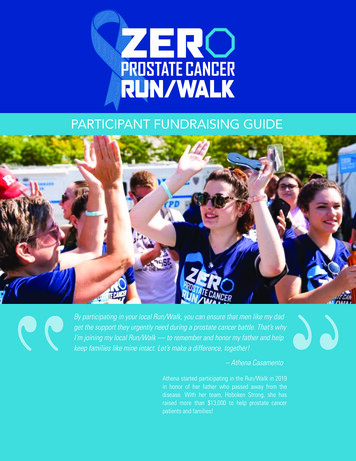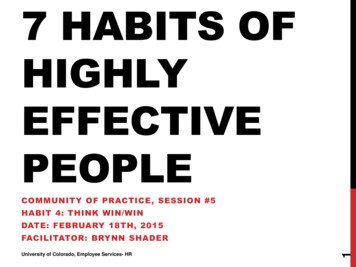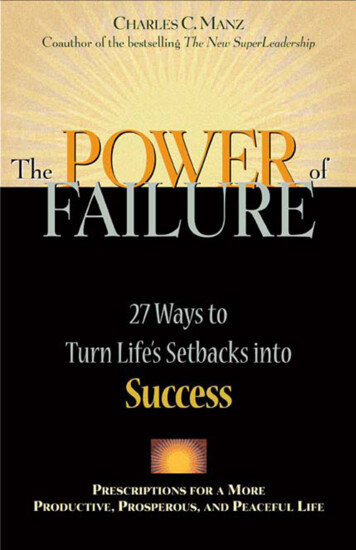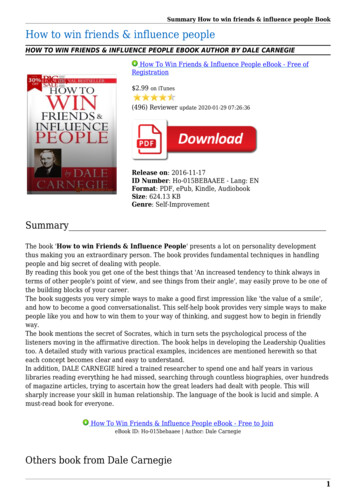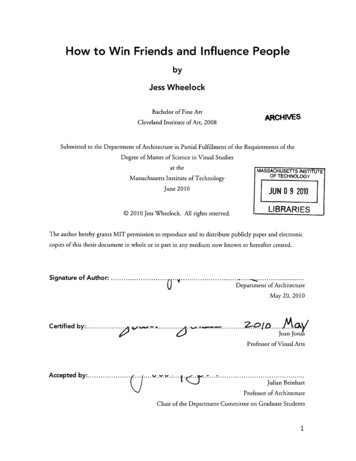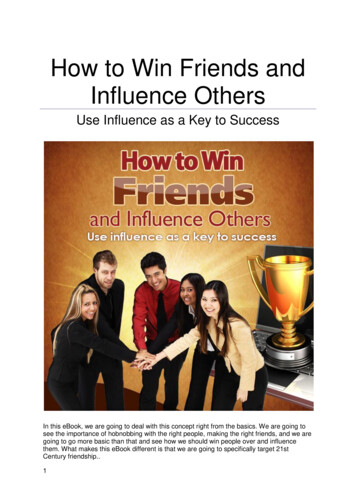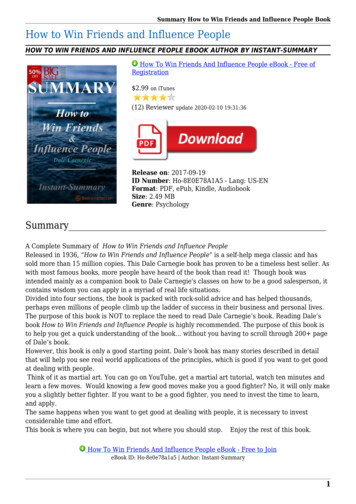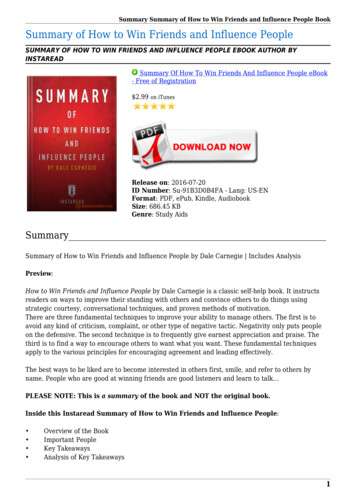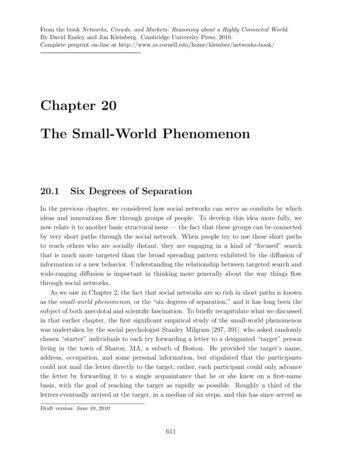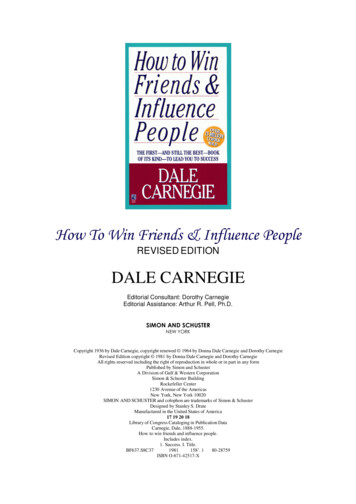
Transcription
How To Win Friends & Influence PeopleREVISED EDITIONDALE CARNEGIEEditorial Consultant: Dorothy CarnegieEditorial Assistance: Arthur R. Pell, Ph.D.SIMON AND SCHUSTERNEW YORKCopyright 1936 by Dale Carnegie, copyright renewed 1964 by Donna Dale Carnegie and Dorothy CarnegieRevised Edition copyright 1981 by Donna Dale Carnegie and Dorothy CarnegieAll rights reserved including the right of reproduction in whole or in part in any formPublished by Simon and SchusterA Division of Gulf & Western CorporationSimon & Schuster BuildingRockefeller Center1230 Avenue of the AmericasNew York, New York 10020SIMON AND SCHUSTER and colophon are trademarks of Simon & SchusterDesigned by Stanley S. DrateManufactured in the United States of America17 19 20 18Library of Congress Cataloging in Publication DataCarnegie, Dale, 1888-1955.How to win friends and influence people.Includes index.1. Success. I. Title.BF637.S8C371981158‘. 180-28759ISBN O-671-42517-X
EIGHT THINGS THIS BOOK WILL HELP YOU ACHIEVE1.Get out of a mental rut, think new thoughts, acquire new visions, discover new ambitions.2. Make friends quickly and easily.3. Increase your popularity.4. Win people to your way of thinking.5.Increase your influence, your prestige, your ability to get things done.6. Handle complaints, avoid arguments, keep your human contacts smooth and pleasant.7. Become a better speaker, a more entertaining conversationalist.8. Arouse enthusiasm among your associates.This book has done all these things for more than ten million readers in thirty-six languages.This Book Is Dedicated to a ManWho Doesn‘t Need to Read It:My Cherished FriendHOMER CROY1
ContentPreface To Revised Edition . 4How The Book Was Written—And Why . .5Nine Suggestions On How To Get The Best Of This Book 8Part One: Fundamental Techniques In Handling People1: If you want to gather honey, don't kick over the beehive. .112: The big secret of dealing with people . .183: He who can do this has the whole world with him. He who cannot walks a lonely way24Part Two: Six Ways To Make People Like You4: Do this and you'll be welcome anywhere . .345: A simple way to make a good impression .406: If you don't do this, you are headed for trouble . .447: An easy way to become a good conversationalist 488: How to interest people .539: How to make people like you instantly. . . 56Part Three: How To Win People To Your Way Of Thinking10: You can‘t win an argument 6311: A sure way of making enemies—and how to avoid it .6712: If you're wrong, admit it . 7213: A drop of honey . .7614: The secret of Socrates . .8015: The safety valve in handling complaints . .8316: How To Get Cooperation .8617: A formula that will work wonders for you. . .8918: What everybody wants .922
19: An appeal that everybody likes .9620: The movies do it. TV does it. Why don't you do it? . .9921: When nothing else works, try this . . 102Part 4: Be A Leader: How To Change People Without Giving Offence Or ArousingResentment22: If you must find fault, this is the way to begin .10623: How to criticize—and not be hated for it . . 10924: A talk about your own mistakes first .11125: No one likes to take orders. . 11426: Let the other person save face 11627: How to spur people on to success . .11828: Give a dog a good name . 12129: Make the fault seem easy to correct. .12330: Making people glad to do what you want .125A Shortcut To Distinction . .1283
Preface To Revised EditionHow to Win Friends and Influence People was first published in 1937 in an edition of only fivethousand copies. Neither Dale Carnegie nor the publishers, Simon and Schuster, anticipated more than thismodest sale. To their amazement, the book became an overnight sensation, and edition after edition rolled offthe presses to keep up with the increasing public demand. How to Win Friends and Influence People took itsplace in publishing history as one of the all-time international bestsellers. It touched a nerve and filled a humanneed that was more than a faddish phenomenon of post-Depression days, as evidenced by its continued anduninterrupted sales into the eighties, almost half a century later.Dale Carnegie used to say that it was easier to make a million dollars than to put a phrase into theEnglish language. How to Win Friends and Influence People became such a phrase, quoted, paraphrased,parodied, used in innumerable contexts from political cartoon to novels. The book itself was translated intoalmost every known written language. Each generation has discovered it anew and has found it relevant.Which brings us to the logical question: Why revise a book that has proven and continues to prove itsvigorous and universal appeal? Why tamper with success?To answer that, we must realize that Dale Carnegie himself was a tireless reviser of his own workduring his lifetime. How to Win Friends and Influence People was written to be used as a textbook for hiscourses in Effective Speaking and Human Relations and is still used in those courses today. Until his death in1955 he constantly improved and revised the course itself to make it applicable to the evolving needs of an evergrowing public. No one was more sensitive to the changing currents of present-day life than Dale Carnegie. Heconstantly improved and refined his methods of teaching; he updated his book on Effective Speaking severaltimes. Had he lived longer, he himself would have revised How to Win Friends and Influence People to betterreflect the changes that have taken place in the world since the thirties.Many of the names of prominent people in the book, well known at the time of first publication, are nolonger recognized by many of today‘s readers. Certain examples and phrases seem as quaint and dated in oursocial climate as those in a Victorian novel. The important message and overall impact of the book is weakenedto that extent.Our purpose, therefore, in this revision is to clarify and strengthen the book for a modern readerwithout tampering with the content. We have not ―changed‖ How to Win Friends and Influence People except tomake a few excisions and add a few more contemporary examples. The brash, breezy Carnegie style is intact—even the thirties slang is still there. Dale Carnegie wrote as he spoke, in an intensively exuberant, colloquial,conversational manner.So his voice still speaks as forcefully as ever, in the book and in his work. Thousands of people all overthe world are being trained in Carnegie courses in increasing numbers each year. And other thousands arereading and studying How to Win Friends and lnfluence People and being inspired to use its principles to bettertheir lives. To all of them, we offer this revision in the spirit of the honing and polishing of a finely made tool.–Dorothy Carnegie(Mrs. Dale Carnegie)4
How This Book Was Written—And WhyDuring the first thirty-five years of the twentieth century, the publishing houses of America printedmore than a fifth of a million different books. Most of them were deadly dull, and many were financial failures.―Many,‖ did I say? The president of one of the largest publishing houses in the world confessed to me that hiscompany, after seventy-five years of publishing experience, still lost money on seven out of every eight books itpublished.Why, then, did I have the temerity to write another book? And, after I had written it, why should youbother to read it?Fair questions, both; and I‘ll try to answer them.I have, since 1912, been conducting educational courses for business and professional men and womenin New York. At first, I conducted courses in public speaking only—courses designed to train adults, by actualexperience, to think on their feet and express their ideas with more clarity, more effectiveness and more poise,both in business interviews and before groups.But gradually, as the seasons passed, I realized that as sorely as these adults needed training in effectivespeaking, they needed still more training in the fine art of getting along with people in everyday business andsocial contacts.I also gradually realized that I was sorely in need of such training myself. As I look back across theyears, I am appalled at my own frequent lack of finesse and understanding. How I wish a book such as this hadbeen placed in my hands twenty years ago! What a priceless boon it would have been.Dealing with people is probably the biggest problem you face, especially if you are in business. Yes,and that is also true if you are a housewife, architect or engineer. Research done a few years ago under theauspices of the Carnegie Foundation for the Advancement of Teaching uncovered a most important andsignificant fact—a fact later confirmed by additional studies made at the Carnegie Institute of Technology.These investigations revealed that even in such technical lines as engineering, about 15 percent of one‘sfinancial success is due to one‘s technical knowledge and about 85 percent is due to skill in human engineering,to personality and the ability to lead people.For many years, I conducted courses each season at the Engineers‘ Club of Philadelphia, and alsocourses for the New York Chapter of the American Institute of Electrical Engineers. A total of probably morethan fifteen hundred engineers have passed through my classes. They came to me because they had finallyrealized, after years of observation and experience, that the highest-paid personnel in engineering are frequentlynot those who know the most about engineering. One can for example, hire mere technical ability inengineering, accountancy, architecture or any other profession at nominal salaries. But the person who hastechnical knowledge plus the ability to express ideas, to assume leadership, and to arouse enthusiasm amongpeople—that person is headed for higher earning power.In the heyday of his activity, John D. Rockefeller said that ―the ability to deal with people is aspurchasable a commodity as sugar or coffee.‖ ―And I will pay more for that ability,‖ said John D., ―than for anyother under the sun.‖Wouldn‘t you suppose that every college in the land would conduct courses to develop the highestpriced ability under the sun? But if there is just one practical, commonsense course of that kind given for adultsin even one college in the land, it has escaped my attention up to the present writing.The University of Chicago and the United Y.M.C.A. Schools conducted a survey to determine whatadults want to study.That survey cost 25,000 and took two years. The last part of the survey was made in Meriden,Connecticut. It had been chosen as a typical American town. Every adult in Meriden was interviewed andrequested to answer 156 questions—questions such as ―What is your business or profession? Your education?How do you spend your spare time? What is your income? Your hobbies? Your ambitions? Your problems?What subjects are you most interested in studying?‖ And so on. That survey revealed that health is the prime5
interest of adults and that their second interest is people; how to understand and get along with people; how tomake people like you; and how to win others to your way of thinking.So the committee conducting this survey resolved to conduct such a course for adults in Meriden. Theysearched diligently for a practical textbook on the subject and found not one. Finally they approached one of theworld‘s outstanding authorities on adult education and asked him if he knew of any book that met the needs ofthis group. ―No,‖ he replied, "I know what those adults want. But the book they need has never been written.‖I knew from experience that this statement was true, for I myself had been searching for years todiscover a practical, working handbook on human relations.Since no such book existed, I have tried to write one for use in my own courses. And here it is. I hopeyou like it.In preparation for this book, I read everything that I could find on the subject—everything fromnewspaper columns, magazine articles, records of the family courts, the writings of the old philosophers and thenew psychologists. In addition, I hired a trained researcher to spend one and a half years in various librariesreading everything I had missed, plowing through erudite tomes on psychology, poring over hundreds ofmagazine articles, searching through countless biographies, trying to ascertain how the great leaders of all ageshad dealt with people. We read their biographies; we read the life stories of all great leaders from Julius Caesarto Thomas Edison. I recall that we read over one hundred biographies of Theodore Roosevelt alone. We weredetermined to spare no time, no expense, to discover every practical idea that anyone had ever used throughoutthe ages for winning friends and influencing people.I personally interviewed scores of successful people, some of them world-famous inventors likeMarconi and Edison; political leaders like Franklin D. Roosevelt and James Farley; business leaders like OwenD. Young; movie stars like Clark Gable and Mary Pickford, and explorers like Martin Johnson, and tried todiscover the techniques they used in human relations.From all this material, I prepared a short talk. I called it ―How to Win Friends and Influence People‖. Isay ―short.‖ It was short in the beginning, but it soon expanded to a lecture that consumed one hour and thirtyminutes. For years, I gave this talk each season to the adults in the Carnegie Institute courses in New York.I gave the talk and urged the listeners to go out and test it in their business and social contacts, and thencome back to class and speak about their experiences and the results they had achieved. What an interestingassignment! These men and women, hungry for self-improvement, were fascinated by the idea of working in anew kind of laboratory—the first and only laboratory of human relationships for adults that had ever existed.This book wasn‘t written in the usual sense of the word. It grew as a child grows. It grew anddeveloped out of that laboratory, out of the experiences of thousands of adults.Years ago, we started with a set of rules printed on a card no larger than a postcard. The next season weprinted a larger card, then a leaflet, then a series of booklets, each one expanding in size and scope. After fifteenyears of experiment and research came this book.The rules we have set down here are not mere theories or guesswork. They work like magic. Incredibleas it sounds, I have seen the application of these principles literally revolutionize the lives of many people.To illustrate: A man with 314 employees joined one of these courses. For years, he had driven andcriticized and condemned his employees without stint or discretion. Kindness, words of appreciation andencouragement were alien to his lips. After studying the principles discussed in this book, this employer sharplyaltered his philosophy of life. His organization is now inspired with a new loyalty, a new enthusiasm, a newspirit of teamwork. Three hundred and fourteen enemies have been turned into 314 friends. As he proudly saidin a speech before the class: ―When I used to walk through my establishment, no one greeted me. My employeesactually looked the other way when they saw me approaching. But now they are all my friends and even thejanitor calls me by my first name.‖This employer gained more profit, more leisure and—what is infinitely more important—he found farmore happiness in his business and in his home.6
Countless numbers of salespeople have sharply increased their sales by the use of these principles.Many have opened up new accounts—accounts that they had formerly solicited in vain. Executives have beengiven increased authority, increased pay. One executive reported a large increase in salary because he appliedthese truths. Another, an executive in the Philadelphia Gas Works Company, was slated for demotion when hewas sixty-five because of his belligerence, because of his inability to lead people skillfully. This training notonly saved him from the demotion but brought him a promotion with increased pay.On innumerable occasions, spouses attending the banquet given at the end of the course have told methat their homes have been much happier since their husbands or wives started this training.People are frequently astonished at the new results they achieve. It all seems like magic. In some cases,in their enthusiasm, they have telephoned me at my home on Sundays because they couldn‘t wait forty-eighthours to report their achievements at the regular session of the course.One man was so stirred by a talk on these principles that he sat far into the night discussing them withother members of the class. At three o‘clock in the morning, the others went home. But he was so shaken by arealization of his own mistakes, so inspired by the vista of a new and richer world opening before him, that hewas unable to sleep. He didn‘t sleep that night or the next day or the next night.Who was he? A naive, untrained individual ready to gush over any new theory that came along? No, farfrom it. He was a sophisticated, blasé dealer in art, very much the man about town, who spoke three languagesfluently and was a graduate of two European universities.While writing this chapter, I received a letter from a German of the old school, an aristocrat whoseforebears had served for generations as professional army officers under the Hohenzollerns. His letter, writtenfrom a transatlantic steamer, telling about the application of these principles, rose almost to a religious fervor.Another man, an old New Yorker, a Harvard graduate, a wealthy man, the owner of a large carpetfactory, declared he had learned more in fourteen weeks through this system of training about the fine art ofinfluencing people than he had learned about the same subject during his four years in college. Absurd?Laughable? Fantastic? Of course, you are privileged to dismiss this statement with whatever adjective you wish.I am merely reporting, without comment, a declaration made by a conservative and eminently successfulHarvard graduate in a public address to approximately six hundred people at the Yale Club in New York on theevening of Thursday, February 23, 1933.―Compared to what we ought to be,‖ said the famous Professor William James of Harvard, ―comparedto what we ought to be, we are only half awake. We are making use of only a small part of our physical andmental resources. Stating the thing broadly, the human individual thus lives far within his limits. He possessespowers of various sorts which he habitually fails to use.‖Those powers which you ―habitually fail to use‖! The sole purpose of this book is to help you discover,develop and profit by those dormant and unused assets.―Education,‖ said Dr. John G. Hibben, former president of Princeton University, ―is the ability to meetlife‘s situations.‖If by the time you have finished reading the first three chapters of this book, if you aren‘t then a littlebetter equipped to meet life‘s situations, then I shall consider this book to be a total failure so far as you areconcerned.―For the great aim of education,‖ said Herbert Spencer, ―is not knowledge but action.‖And this is an action book.–Dale Carnegie19367
Nine Suggestions On How To Get The Most Out Of This Book1. If you wish to get the most out of this book, there is one indispensable requirement, one essential infinitelymore important than any rule or technique. Unless you have this one fundamental requisite, a thousand ruleson how to study will avail little, and if you do have this cardinal endowment, then you can achieve wonderswithout reading any suggestions for getting the most out of a book.What is this magic requirement? Just this: a deep, driving desire to learn, a vigorous determination toincrease your ability to deal with people.How can you develop such an urge? By constantly reminding yourself how important these principles are toyou. Picture to yourself how their mastery will aid you in leading a richer, fuller, happier and morefulfilling life. Say to yourself over and over: ―My popularity, my happiness and sense of worth depend to nosmall extent upon my skill in dealing with people.‖2.Read each chapter rapidly at first to get a bird‘s-eye view of it. You will probably be tempted then to rushon to the next one. But don‘t, unless you are reading merely for entertainment. But if you are readingbecause you want to increase your skill in human relations, then go back and reread each chapterthoroughly. In the long run, this will mean saving time and getting results.3. Stop frequently in your reading to think over what you are reading. Ask yourself just how and when youcan apply each suggestion.4. Read with a crayon, pencil, pen, magic marker or highlighter in your hand. When you come across asuggestion that you feel you can use, draw a line beside it. If it is a four-star suggestion, then underscoreevery sentence or highlight it, or mark it with ―****‖. Marking and underscoring a book makes it moreinteresting, and far easier to review rapidly.5. I knew a woman who had been office manager for a large insurance concern for fifteen years. Every month,she read all the insurance contracts her company had issued that month. Yes, she read many of the samecontracts over month after month, year after year. Why? Because experience had taught her that that wasthe only way she could keep their provisions clearly in mind.I once spent almost two years writing a book on public speaking and yet I found I had to keep going backover it from time to time in order to remember what I had written in my own book. The rapidity with whichwe forget is astonishing.So, if you want to get a real, lasting benefit out of this book, don‘t imagine that skimming through it oncewill suffice. After reading it thoroughly, you ought to spend a few hours reviewing it every month. Keep iton your desk in front of you every day. Glance through it often. Keep constantly impressing yourself withthe rich possibilities for improvement that still lie in the offing. Remember that the use of these principlescan be made habitual only by a constant and vigorous campaign of review and application. There is noother way.6.Bernard Shaw once remarked, ―If you teach a man anything, he will never learn.‖ Shaw was right. Learningis an active process. We learn by doing. So, if you desire to master the principles you are studying in thisbook, do something about them. Apply these rules at every opportunity. If you don‘t you will forget themquickly. Only knowledge that is used sticks in your mind.You will probably find it difficult to apply these suggestions all the time. I know because I wrote the book,and yet frequently I found it difficult to apply everything I advocated. For example, when you aredispleased, it is much easier to criticize and condemn than it is to try to understand the other person‘sviewpoint. It is frequently easier to find fault than to find praise. It is more natural to talk about what youwant than to talk about what the other person wants and so on. So, as you read this book, remember that youare not merely trying to acquire information. You are attempting to form new habits. Ah yes, you areattempting a new way of life. That will require time and persistence and daily application.So refer to these pages often. Regard this as a working handbook on human relations; and whenever you areconfronted with some specific problem—such as handling a child, winning your spouse to your way of8
thinking, or satisfying an irritated customer—hesitate about doing the natural thing, the impulsive thing.This is usually wrong. Instead, turn to these pages and review the paragraphs you have underscored. Thentry these new ways and watch them achieve magic for you.7. Offer your spouse, your child or some business associate a dime or a dollar every time he or she catchesyou violating a certain principle. Make a lively game out of mastering these rules.8. The president of an important Wall Street bank once described, in a talk before one of my classes, a highlyefficient system he used for self-improvement. This man had little formal schooling; yet he had become oneof the most important financiers in America, and he confessed that he owed most of his success to theconstant application of his homemade system. This is what he does and I‘ll put it in his own words asaccurately as I can remember.―For years I have kept an engagement book showing all the appointments I had during the day. My familynever made any plans for me on Saturday night, for the family knew that I devoted a part of each Saturdayevening to the illuminating process of self-examination and review and appraisal. After dinner I went off bymyself, opened my engagement book, and thought over all the interviews, discussions and meetings thathad taken place during the week. I asked myself: ‗What mistakes did I make that time?‘ ‗What did I do thatwas right, and in what way could I have improved my performance?‘ ‗What lessons can I learn from thatexperience?‘―I often found that this weekly review made me very unhappy. I was frequently astonished at my ownblunders. Of course, as the years passed, these blunders became less frequent. Sometimes I was inclined topat myself on the back a little after one of these sessions. This system of self-analysis, self-education,continued year after year, did more for me than any other one thing I have ever attempted.―It helped me improve my ability to make decisions and it aided me enormously in all my contacts withpeople. I cannot recommend it too highly.‖Why not use a similar system to check up on your application of the principles discussed in this book? Ifyou do, two things will result.First, you will find yourself engaged in an educational process that is both intriguing and priceless. Second,you will find that your ability to meet and deal with people will grow enormously.9.You will find at the end of this book several blank pages on which you should record your triumphs in theapplication of these principles. Be specific. Give names, dates, results. Keeping such a record will inspireyou to greater efforts; and how fascinating these entries will be when you chance upon them some eveningyears from now!In order to get the most out of this book:a. Develop a deep, driving desire to master the principles of human relations.b. Read each chapter twice before going on to the next one.c. As you read, stop frequently to ask yourself how you can apply each suggestion.d. Underscore each important idea.e. Review this book each month.f. Apply these principles at every opportunity. Use this volume as a working handbook to help you solveyour daily problems.g. Make a lively game out of your learning by offering some friend a dime or a dollar every time he or shecatches you violating one of these principles.h. Check up each week on the progress you are making. Ask yourself what mistakes you have made, whatimprovement, what lessons you have learned for the future.i. Keep notes in the back of this book showing how and when you have applied these principles.9
PART ONEFundamental Techniques In Handling People10
1“IF YOU WANT TO GATHER HONEY, DON’T KICK OVERTHE BEEHIVE.”On May 7, 1931, the most sensational manhunt New York City had ever known had come to its climax.After weeks of search, ―Two Gun‖ Crowley—the killer, the gunman who didn‘t smoke or drink—was at bay,trapped in his sweetheart‘s apartment on West End Avenue.One hundred and fifty policemen and detectives laid siege to his top-floor hideaway. They choppedholes in the roof; they tried to smoke out Crowley, the ―cop killer,‖ with teargas. Then they mounted theirmachine guns on surrounding buildings, and for more than an hour one of New York‘s fine residential areasreverberated with the crack of pistol fire and the rut-tat-tat of machine guns. Crowley, crouching behind anover-stuffed chair, fired incessantly at the police. Ten thousand excited people watched the battle. Nothing likeit ever been seen before on the sidewalks of New York.When Crowley was captured, Police Commissioner E. P. Mulrooney declared that the two-gundesperado was one of the most dangerous criminals ever encountered in the history of New York. ―He will kill,‖said the Commissioner, ―at the drop of a feather.‖But how did ―Two Gun‖ Crowley regard himself? We know, because while the police were firing intohis apartment, he wrote a letter addressed ―To whom it may concern, ‖ and, as he wrote, the blood flowing fromhis wounds left a crimson trail on the paper. In this letter Crowley said, ―Under my coat is a weary heart, but akind one—one that would do nobody any harm.‖A short time before this, Crowley had been having a necking party with his girlfriend on a country roadout on Long Island. Suddenly a policeman walked up to the car and said, ―Let me see your license.‖Without saying a word, Crowley drew his gun and cut the policeman down with a shower of lead. Asthe dying officer fell, Crowley leaped out of the car, grabbed the officer‘s revolver, and fired another bullet intothe prostrate body. And that was the killer who said, ―Under my coat is a weary heart, but a kind one—one thatwould do nobody any harm.‘Crowley was sentenced to the electric chair. When he arrived at the death house in Sing Sing, did hesay, ―This is what I get for killing people‖? No, he said, ―This is what I g
Dale Carnegie used to say that it was easier to make a million dollars than to put a phrase into the English language. How to Win Friends and Influence People became such a phrase, quoted, paraphrased, parodied, used in innumerable contexts from political cartoon to novels. The book itself was translated into almost every known written language.
